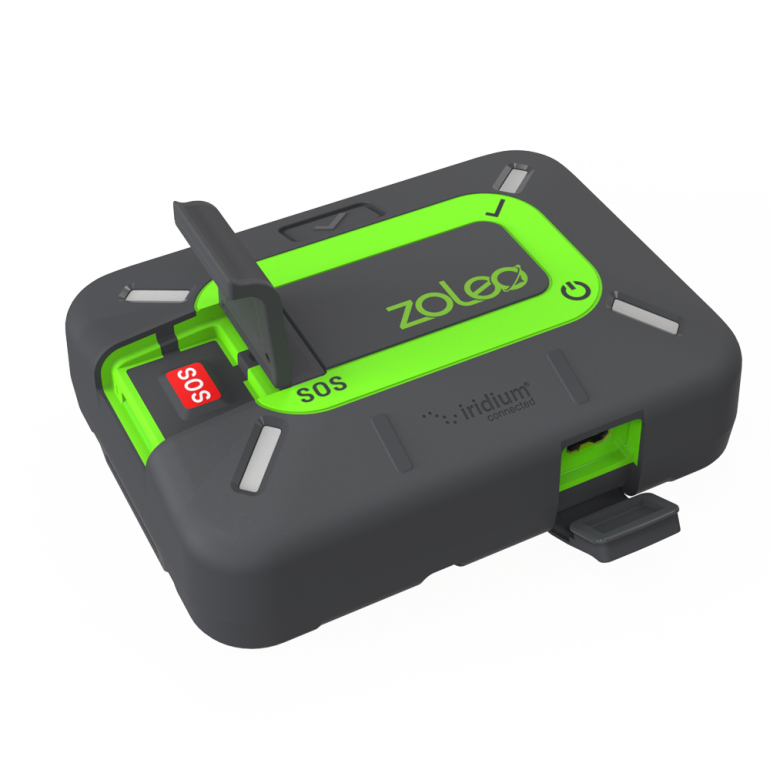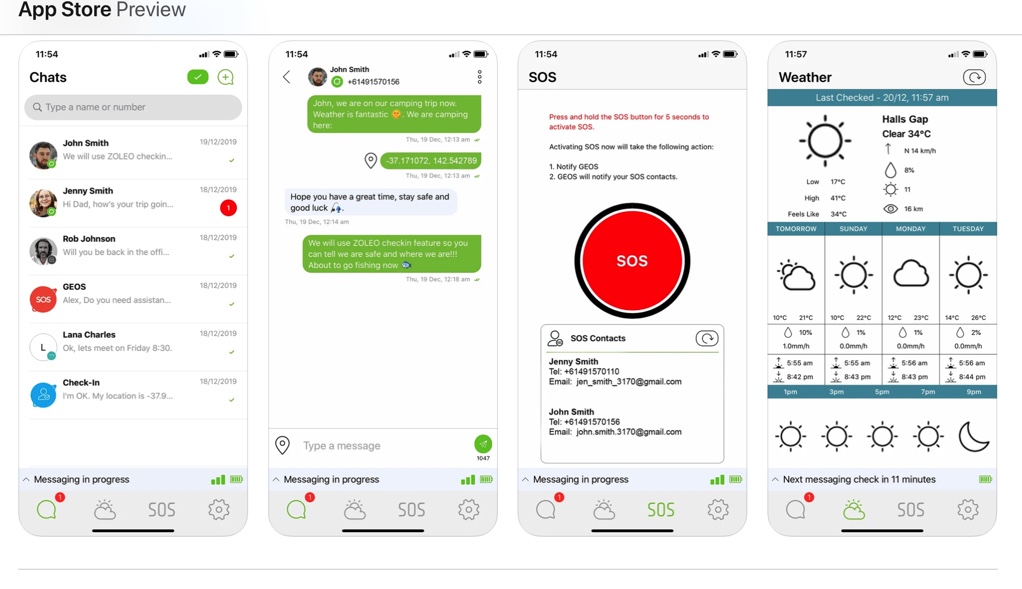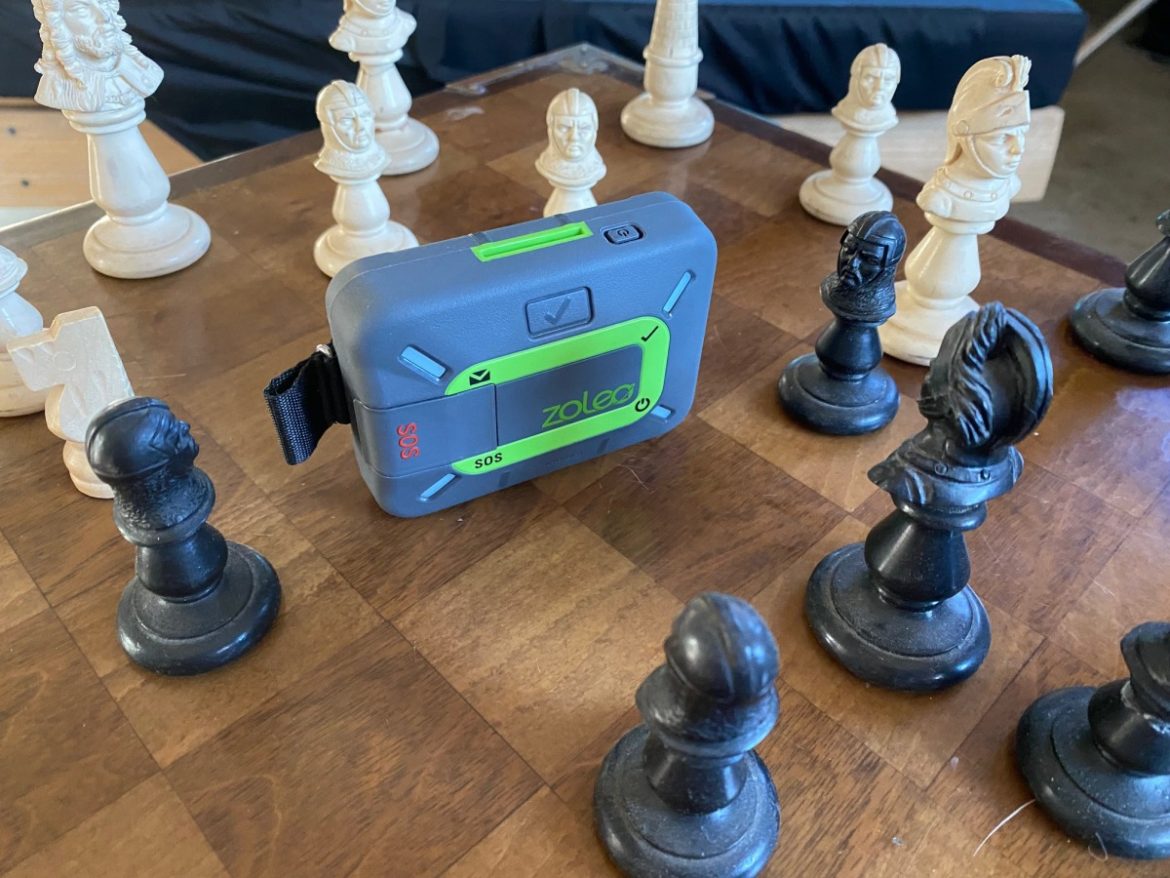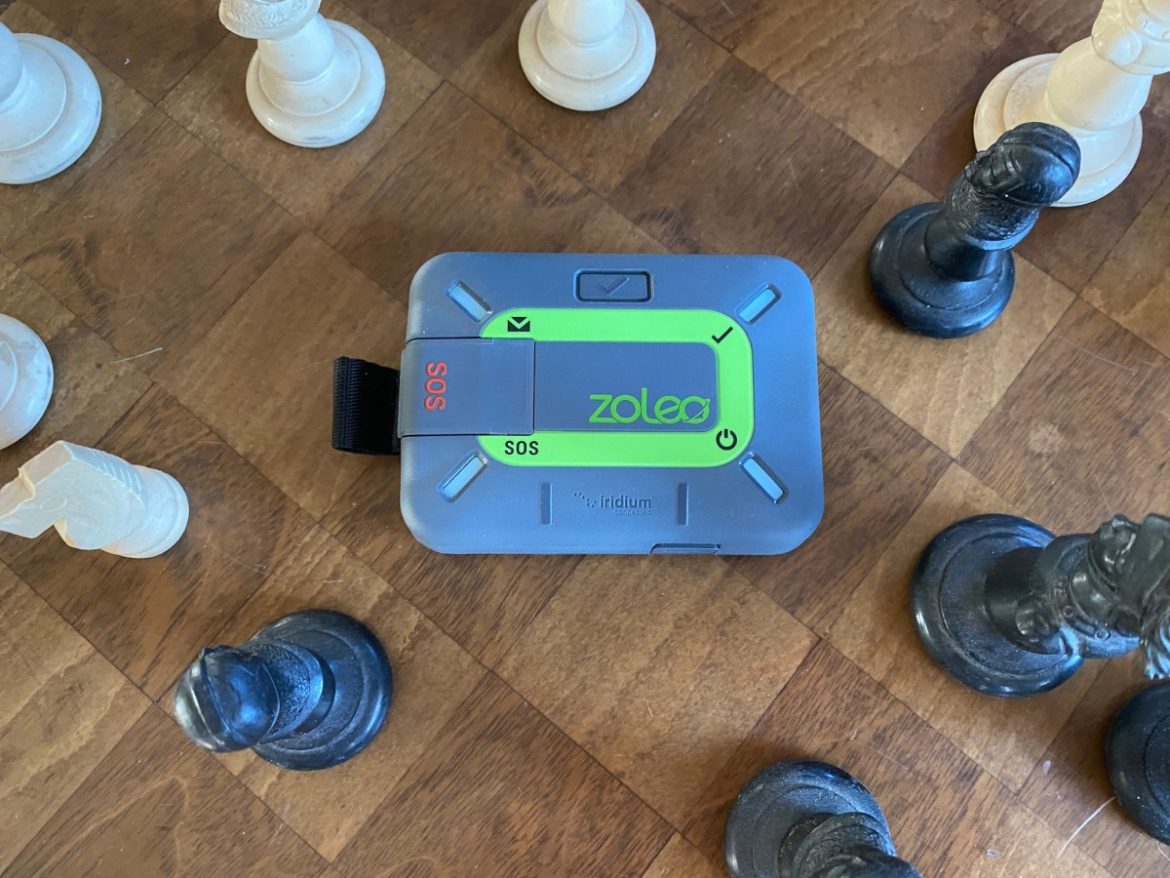
The Zoleo satellite communicator provides a link to the outside world when off the grid. Here, the unit’s SOS button and micrio-USB port are revealed. Photo: Zoleo
“Hello from outer space,” I type into the text box on my Zoleo app. I hover my finger for a split second over the button, then hit send. Green lights flash on the device, and I wait patiently for a return message from my friend Zoë. I am testing the Zoleo Satellite Messenger in preparation for an anticipated sojourn into a backcountry lodge in BC, where I will be working as a sous chef and tail guide this winter, and for a week-long packrafting trip on the Grand Canyon in late January. Having some way of staying in touch with friends and family back home, while also enabling a critical call for help in the event of an emergency during these remote, off-grid experiences are top priorities.
The Zoleo Global Satellite Communicator is a tidy package. It measures 65×90 mm and is 12mm thick, with well labeled and easy-to-understand buttons, intuitive ergonomics, and nothing to really break. The Zoleo’s unverified weight is 150g. Along with other satellite-based messengers like a Garmin inReach or Spot X, Zoleo’s unit allows communication when cellular service is lacking, the ability to share your location, and one-button SOS initiation for help in the event of an emergency.
The Zoleo costs $199 for the device and requires a monthly subscription fee ranging from $20-50 per month. The plans require a $20 activation fee with no service suspensions during the first three months of use, and $4 thereafter if you suspend service, but maintain the account. You can reactivate for free anytime thereafter.
Although this is not a rundown on plans (make sure you read the details) a basic plan for the more expensive Garmin inReach Mini ($350), Garmin inReach Explore + ($450.00), or Spot X ($250) is $11.95 a month for an annual plan. The Garmin plans have a $29.95 activation fee, while the SpotX plan activation fee is $19.95. The basic plans from Garmin and Spot include fewer messages and characters per message compared to the base plan from Zoleo.
Editor’s note: If you are getting serious about one of these devices, we encourage you to read up on plan specifics. You’re not only buying a device, you are buying a plan too. Garmin Plans, Spot plans, Zoleo plans.
The Zoleo may be better suited to a user who wants or needs a larger number of text messages in the field and is ok with using their phone for two-way messaging. That’s the strong suit of the Zoleo, ease of messaging when bluetoothed to a phone. You send, receive, and read your Zoleo messages in their proprietary app. The app features app-to-app messaging and emails. The Zoleo unit, however, does not feature a screen to read incoming or outgoing messages.
With its comparatively lower upfront cost, a Zoleo device comes with some loss of functionality that might not be critical – depending on your needs. True two-way messaging with the Zoleo requires a Bluetooth tethered phone. The inReach series allows two-way messaging using the stand-alone device, albeit via a cumbersome typing experience using the Mini and a more streamlined method on the inReach Explore + and its digital keyboard. The Spot X device includes a small keyboard, making custom text generation easier.
As skiers, I can imagine scenarios where the ability to customize texts might be useful; maybe you are communicating vitals to search and rescue. Again, the Zoleo does not provide two-way messaging without connectivity to a phone. The comment thread in this WildSnow article is a good read regarding the value of two-way comms, even if limited to text when emergencies arise.
So let’s imagine your phone dies, or is lost. What can you do with a Zoleo untethered to a phone? You can still send an SOS message or an “all is ok” message to 2 pre-selected contacts. The “check-in” button, when pressed, sends a message which reads “I’m ok” and sends your GPS location to the two pre-programmed contacts in your device.
A Zoleo Location Share subscription for $6 a month lets you live-share your current location with up to 5 contacts at a user-specified interval. The cost seems a bit pricey, as the Garmin and Spot services include live tracking with a basic plan. Live tracking can be great if you are undertaking a multi-day traverse and want to inform others of your progress or let others see your location if they are joining you.
Downloading the Zoleo app and setting up an account was pretty straightforward and took me about 15 minutes once I charged the device and had the app on my phone. The app syncs with your contacts so you can message anyone in your phone via the device, and you also have a dedicated device number, so anyone with your Zoleo contact can quickly and easily send you messages any time.
During setup you are prompted to select two people as your emergency and check in contacts who will receive messages should you hit either the “SOS” or “All OK” buttons on the device. It’s a good idea to alert those contacts to this fact before you start sending messages from space so they will know what to do in case of an emergency. With The Zoleo app on your phone, messaging is a familiar experience and intuitive, but uses the Zoleo device to send and receive data via satellites rather than a cellular signal.

Zoleo’s app includes screens for messaging, a basic weather forecast, and activating the SOS function. Photo: Screenshot Apple App Store.
All this messaging and tracking adds up to lots of battery power, so if you intend to send lots of texts from the field on an extended trip, bring a spare battery to charge your phone and the device or the means to recharge via solar power. Users looking for basic satellite check-ins and SOS capabilities may be better served with one of the other available options from a cost and hardware standpoint.
What happens when you hit the SOS button? According to Zoleo, the International Emergency Response Coordination Center (IERCC) at GEOS (a private company) monitors SOS alerts initiated from your device and coordinates Search and Rescue efforts on your behalf. SOS deployment can be done from either the device alone or in the app on your phone. SOS activation also sends messages to your two pre-selected on-device contacts with your location and an SOS alert.
The Zoleo taps into the iridium satellite network, the same one used by Garmin, while Spot devices tap into the Globalstar sat network, so coverage should be similar. The Zoleo can also use cellular and wifi to send/deliver messages automatically to you on the lowest cost network based on availability. I’m uncertain why you wouldn’t just use your phone to send messages when cellular or wifi is available. Still, at least you know you won’t use up your precious satellite messages unnecessarily if sending messages through Zeleo’s app.
I am interested in testing the Zoleo in the coming months, and I am sure my mother will be excited to hear from me more often now that I’m testing a satellite uplink. She tends to worry when I am off-grid for extended periods in the mountains.
And that return text from Zoë ? It came through with no problem. Unfortunately, photo messaging isn’t available yet, but we can all dream. Zoleo is available at Zoleo.com and through other online retailers. Long-term review coming after I put in some solid off-grid hours.
Other features: USB charging, IP 68 waterproof rating (fit enough to withstand dust, dirt and sand, and resistant to submersion up to a maximum depth of 1.5m underwater for up to thirty minutes), SOS button cover to prevent accidental deployment, carabiner attachment and USB charging cable included in the box.
Barry Wicks, also known as @wicknasty, demphasizes the nasty and embraces the kindness. He lives in Bend, Oregon where in a parallel universe he covets all things cycling. And although he might not admit it, some say he was once quite speedy on a bike. Also, amongst WildSnow writers, he has the best hair.


